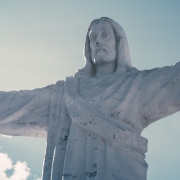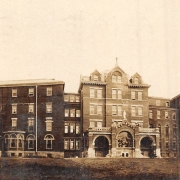“This sickness will not end in death. No, it is for God’s glory so that God’s Son may be glorified through it”
– (Jn. 11:4)
The decision of the ruling elite to have Jesus killed did not occur during the Passion week also known as Easter week. It actually occurred three months earlier. Of particular concern for Caiaphas, the chief Priest, and the ruling body, called the Sanhedrin, was Jesus raising a local man from the dead. This incident had caused many to cross over from just wondering about Jesus to believing he was their answer—perhaps the long-awaited Messiah.
While Jesus was on the eastern shore of the Jordan, two sisters, Martha and Mary, who lived in Bethany, faced a crisis. Their brother, Lazarus, had fallen ill and was on the brink of death. Martha and Mary were early believers in Jesus as the Messiah, particularly since Jesus had healed their father from the debilitating effects of leprosy. In gratitude, the sisters, along with Lazarus and their father, became devoted followers of Jesus. Due to their deep faith, Jesus developed a special bond with the family. Thus, when Lazarus became critically ill, they immediately sent word to Jesus, seeking his help.
When Jesus received word of Lazarus’s illness, he said, “This sickness will not end in death. No, it is for God’s glory so that God’s Son may be glorified through it” (Jn. 11:4). Remarkably, Jesus didn’t go to them immediately; he waited two days. Then, on the third day, he told the Twelve,
“Let’s go back to Judea.”
“But Rabbi,” they said, “a short while ago the Jews there tried to stone you, and yet you are going back?”
Jesus replied, “Are there not twelve hours of daylight? Anyone who walks in the daytime will not stumble, for they see by this world’s light. It is when a person walks at night that they stumble, for they have no light.” (Jn. 11:7–10)
After this, Jesus told them Lazarus had only fallen asleep. But still fearful, the Twelve said, “Lord if he sleeps, he will get better” (Jn. [11:13]). But the Twelve still didn’t understand.
Then Jesus became franker and said, “Lazarus is dead, and for your sake, I am glad I was not there, so that you may believe. But let us go to him” (Jn. [11:14]–15). Jesus had a plan. While it included saving a close friend, it also included showing many others the glory of God.
The Twelve did not want to go anywhere near Jerusalem, knowing Jesus was despised by Caiaphas and the other leaders. Getting this close to Jerusalem threatened both Jesus’s life and their own, so they appealed to Jesus not to go.
However, the always loyal and pragmatic Thomas said to the other 11, “Let us also go, that we may die with him” (Jn. [11:16]). Thomas knew that by going to help Lazarus, the whole band of apostles might be killed. Despite the risk, he was driven by his strict loyalty to Jesus. Interestingly, Thomas, throughout the centuries, has been called the doubting Thomas, but here we find a loyal Thomas, willing to die with and for Jesus.
In contemporary times, many have mistaken Thomas’s pragmatism for doubt. As evidenced by his willingness to go with Jesus, we can see that nothing could be further from the truth. Though pragmatic, his loyalty to Jesus and his search for truth would become very evident during the following months.
As they approached Bethany, Martha met them and said to Jesus,
“If you had been here, my brother would not have died. But I know that even now God will give you whatever you ask.”
Jesus said to her, “Your brother will rise again.”
Martha answered, “I know he will rise again in the resurrection at the last day.”
Jesus said to her, “I am the resurrection and the life. The one who believes in me will live, even though they die; and whoever lives by believing in me will never die. Do you believe this?”
“Yes, Lord,” she replied, “I believe that you are the Messiah, the Son of God, who is to come into the world.” (Jn. [11:21]–27)
Martha’s faith in Jesus was very evident; her faith exceeded that of many, including the Twelve who had been traveling with Jesus.
Martha went back to Mary and told her Jesus was coming. Ecstatic, Mary and many friends immediately went to the outskirts of Bethany to meet Jesus. The many friends who were with Mary to comfort her because of her brother’s death followed her.”
As she approached Jesus, he could see she was crying. He also saw the many friends with her, and, in his full humanity, he became deeply moved and troubled. He said:
“Where have you laid him?”
The crowd replied, “Come and see, Lord.” (Jn. [11:33]; 34)
Jesus, seeing the outpouring of grief, in his humanness, began to weep as well.
Many in the crowd exclaimed, “See how he loved him.”
But some cynically asked, “Could not he who opened the eyes of the blind man have kept this man from dying?” (Jn. [11:36]-37).
Those who were cynical were referring to an earlier incident in which Jesus had healed a beggar who had been blind since birth. This event caused an uproar among the Pharisees because Jesus had healed the man on the Sabbath. Instead of being thankful or amazed that Jesus had performed this feat, they criticized him.
In turn, their uproar had only served to make the Pharisees look silly to those who had heard of or witnessed the miraculous event.
As he usually did, Jesus ignored the cynicism and doubters, continuing toward Lazarus’s burial tomb. Upon His arrival, Jesus asked that the stone be removed. Martha, worried about the potential bad odor after the body had lain there for several days, warned Jesus against removing the stone. However, Jesus looked at Martha and said, “Did I not tell you that if you believe, you will see the glory of God?” (Jn. [11:40]). Those near the tomb then removed the stone.
Looking around at the crowd, Jesus knew many in the crowd would become witnesses of his upcoming actions. Raising his head with his arms outstretched, he looked up to the sky and said,
Father, I thank you that you have heard me. I know that you always hear me, but I say this for the benefit of the people standing here, that they may believe that you sent me. (Jn. [11:41]–42)
After saying this, Jesus loudly commanded Lazarus to “come forth.” Lazarus emerged from the tomb, wrapped in strips of linen and cloth on his face. Jesus asked those nearby to unbind him and dress him.
Many of the crowd who had come to comfort Martha and Mary saw this and were amazed. Weeping, some even fell to their knees and looked up to the sky and thanked God. Most who were present now believed Jesus was more than a great healer; he was their Savior.
But some, hoping to gain favor, went to the leaders in Jerusalem and told them what had happened.
Upon hearing about this event, Caiaphas, the chief priest, quickly convened a meeting of the Sanhedrin to discuss the reports surrounding Jesus and the resurrection of Lazarus. Caiaphas requested a detailed account of Lazarus being raised from the dead. Those who had gathered information from the attendees relayed what they had learned. By and large, the accounts from these individuals were consistent with the testimonies of eyewitnesses.
The more Caiaphas and the Sanhedrin heard, the more alarmed they became.
Many who witnessed the event came to believe that Jesus was sent by God, a belief that deeply concerned Caiaphas and the other leaders. Distraught and fearful, some members of the Sanhedrin posed a question to Caiaphas, “What are we accomplishing? Here is this man performing many miracles. If we allow him to continue in this way, everyone will believe in him. The Romans will then intervene, seizing both our temple and our nation” (Jn. [11:47]–48).
The gravity of both scenarios was becoming increasingly evident. Undoubtedly, Jesus was presenting a novel way of life to the common people, one that wasn’t predicated on fear. The Romans recognized that the Sanhedrin and the priests held sway over the masses, which facilitated their governance. Jesus’s burgeoning influence among the locals jeopardized this delicate balance.
Caiaphas realized that it was time to address the threat of Jesus. He also understood the Sanhedrin’s needed to not act rashly. Jesus’ removal would have to be executed with care and tact to avoid inciting public unrest. It would be challenging but achievable with skillful action. They needed to remain calm as they moved against Jesus.
News of this meeting reached Jesus through those who had overheard the discussions and the subsequent decisions. Knowing it wasn’t yet his time to confront the leaders of Jerusalem, he withdrew from the public eye, retreating to the wilderness and the ancient tribal community of Ephraim.



